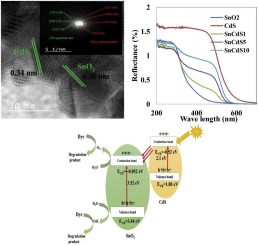Journal of Photochemistry and Photobiology A: Chemistry ( IF 4.1 ) Pub Date : 2020-01-22 , DOI: 10.1016/j.jphotochem.2020.112403 Emad E. El-Katori , M.A. Ahmed , A.A. El-Bindary , Aly M. Oraby

|
An efficient and recyclable CdS/SnO2 heterostructure containing various proportions of CdS (0–10) wt % was synthesized for photocatalytic degradation of methylene blue dye under UV and natural sunlight radiations. Mesoporous SnO2 nanoparticles of surface area 19.2 m2/g and particle size 34 nm with well definite slit pore structure were synthesized by sol-gel route using span as structure and pore directing agent. The physicochemical properties of the novel nanoparticles were investigated by X-ray diffraction [XRD], N2-adsorption-desorption isotherm, diffuse reflectance spectra [DRS], X-ray photoelectron spectroscopy [XPS], photoluminescence [PL] and high resolution transmission electron microscope [HRTEM]. CdS quantum dots of size 9 nm, surface area 26.5 m2/g and wide mesoporous size (pore radius = 119.2 Å) were incorporated homogeneously on the surface of SnO2 forming an efficient heterojunction that cause a remarkable reduction in the band gap energy of SnO2 from 3.52 to 2.53 eV. These novel heterostructures facilitate the electron transfer from CB of CdS of more negative potential (-0.52 eV) to that of SnO2 of less negative potential (-0.04 eV), thus enhancing the separation efficiency of the charge carrier and increasing the life time of the reactive radicals. It is emphasized that the photocatalytic reactivity of SnCd5 is more than twice that of SnO2 and CdS nanoparticles. Experiments with different quenchers indicate that the electrons conduction band and superoxide radicals are the predominant reactive species on SnCd5 hybrid nanoparticles, however, hydroxyl radical and positive holes are more efficient on pure SnO2 surface. The as-synthesized SnCd5 nanoparticles exhibits an excellent photocatalytic stability and the catalyst retains 83 % of its reactivity after five consecutive cycles revealing that there is no deterioration in the catalyst structure.
中文翻译:

CdS / SnO 2异质结构纳米粒子作为可见光活性光催化剂对去除亚甲基蓝染料的影响
合成了一种高效且可循环利用的CdS / SnO 2异质结构,其中包含各种比例的CdS(0-10)wt%,用于在紫外线和自然阳光照射下光催化降解亚甲基蓝染料。以跨度为结构和孔导向剂,通过溶胶-凝胶法合成了表面积为19.2 m 2 / g,粒径为34 nm,具有确定的狭缝孔结构的介孔SnO 2纳米粒子。通过X射线衍射[XRD],N 2研究了新型纳米颗粒的理化性质。-吸附-解吸等温线,漫反射光谱[DRS],X射线光电子能谱[XPS],光致发光[PL]和高分辨率透射电子显微镜[HRTEM]。尺寸为9 nm,表面积为26.5 m 2 / g和宽介孔尺寸(孔半径= 119.2Å)的CdS量子点均匀地掺入SnO 2的表面上,形成有效的异质结,从而显着降低了带隙能。 SnO 2从3.52降至2.53 eV。这些新颖的异质结构促进了电子从负电位(-0.52 eV)的CdS的CB转移到SnO 2的电子负电势较小(-0.04 eV),因此提高了电荷载流子的分离效率并延长了反应性自由基的寿命。要强调的是,SnCd5的光催化反应性是SnO 2和CdS纳米粒子的两倍以上。使用不同淬灭剂的实验表明,电子导带和超氧化物自由基是SnCd5杂化纳米颗粒上的主要反应物种,但是,羟基自由基和正空穴在纯SnO 2表面上更有效。刚合成的SnCd5纳米颗粒表现出出色的光催化稳定性,并且在连续五个循环后催化剂保留了其83%的反应性,表明催化剂的结构没有恶化。











































 京公网安备 11010802027423号
京公网安备 11010802027423号